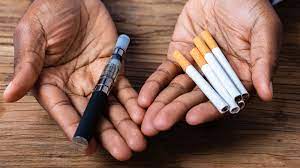For social media enthusiasts, it is not uncommon to find numerous users of different social network sites posting videos and pictures holding a “small pen” with a “cool wave” of smoke around them. One might presume the small device to be a flash disk of sorts but in reality, it’s the new and improved “electronic cigarette.”
The new generation of cigarettes have been upon us for a while now. They are commonly referred to as “vapes, vaporizers, or e-cigarettes.” Their design is trendy and more tech-forward as opposed to the traditional form. With no regulation in the Kenyan law; vaping can be done anywhere from PSVs to Public spaces to hotels, etc. How common is the trend? Jonah, “I love vaping it gives me a new form of high and relaxation. I feel like it’s less harmful than cigarettes.” Grace, “I have vaped before, I didn’t like it but it’s a cool pass time for people my age.” These sentiments represent a percentage of the modern urban youths who engage in the activity in their leisure. With the assumption, that vaping is better than smoking.
Internationally, Vaping is encouraged to aid traditional chain smokers to quit the habit, “There’s almost no doubt that vaping exposes you to fewer toxic chemicals than smoking traditional cigarettes. However, there has been an outbreak of lung injuries and deaths associated with vaping. In February 2020, the Centers for Disease Control and Prevention (CDC) confirmed 2,807 cases of e-cigarette or vaping use-associated lung injury (EVALI) and 68 deaths attributed to that condition.” Michael Blaha, M.D., M.P.H., director of clinical research at the Johns Hopkins Ciccarone Center for the Prevention of Heart Disease.
Vaping may even be more dangerous than smoking, “People need to understand that e-cigarettes are potentially dangerous to your health. Emerging data suggest and link it to chronic lung disease and asthma, as well as associations between dual use of e-cigarettes and smoking with cardiovascular disease. You’re exposing yourself to all kinds of chemicals that we don’t yet understand and that are probably not safe.”
Following trends is not always beneficial, and as a country with an estimated 75% youth population, with no regulation in place on such a substance is worrying. The first step of advocacy is awareness, what next should we do?







